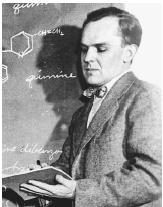Robert Burns Woodward

AMERICAN CHEMIST
1917–1979
Robert Burns Woodward is generally recognized as the leading organic chemist of the twentieth century. He and his coworkers determined the structures of biologically active natural products, developed theoretical rules for predicting the outcomes of organic reactions, and synthesized some of the most complex molecules known to humans. In 1965 Woodward received the Nobel Prize in chemistry for his "outstanding achievements in the art of organic synthesis."
Woodward was born on April 10, 1917, in Boston, Massachusetts. His father, Arthur Woodward, died of influenza eighteen months later. His mother, Margaret Burns Woodward, remarried, and the family eventually settled in Quincy, Massachusetts. Young Woodward fell in love with chemistry while doing experiments with his boyhood pals in Quincy: He ate, drank, and slept chemistry and dreamed up ways to synthesize the antimalarial drug quinine.
At age sixteen Woodward entered the Massachusetts Institute of Technology (MIT) and raced through their chemistry studies in record time: It took him three years to get his B.S. degree (in 1936), and only one to get his Ph.D. (in 1937). After a summer stint at the University of Illinois, Woodward joined the chemistry department at Harvard University, where, for the next forty-two years, he urged chemists worldwide to accept the creative challenges that organic synthesis had introduced.
Woodward was always attracted to molecules with novel structures or interesting biological activities. He attacked the synthesis of steroids during his years at MIT, and with American chemist Bill Doering in 1944, he published the paper that described the fulfillment of his boyhood dreams: the synthesis of quinine. What Woodward and Doering actually reported was the twenty-step synthesis of a quinotoxine, a molecule whose conversion into quinine had been reported by the German chemist Paul Rabe in 1918. Rabe's reported synthesis of quinine was later discredited, but that in no way diminished the impact of Woodward's beautifully planned synthesis of quinotoxine.
After quinine, Woodward and his coworkers synthesized a series of increasingly complex natural products, such as reserpine , lysergic acid , chlorophyll , cephalosporin C , vitamin B 12 , and erythromycin . Each synthesis had its own unique set of challenges, but Woodward's insistence on careful planning, great attention to detail, and observation shines through in all of them. He took full advantage of the latest advances in organic stereochemistry and reaction mechanisms and pushed for the use of spectroscopic and analytical tools to determine the structures of reaction products. Woodward used the same approach to determine the structures of natural (plant- or animal-derived) and synthetic products. During World War II he was asked to join the team of scientists that was investigating the miracle antibiotic penicillin. In characteristic Woodward fashion, he summarized all of the available chemical and spectroscopic data and was the first to propose the β -lactam structure for penicillin. After penicillin came strychnine, tetracycline, and, with its unprecedented iron-sandwich structure, ferrocene.
Woodward saw organic synthesis as a way to advance science and to solve practical problems. One need only look to his vitamin B 12 work to illustrate this. A reaction that Woodward had planned to use as part of the early stages of the synthesis of vitamin B 12 gave a product with unexpected stereochemistry, leading the perplexed Woodward to look for similar reactions in the organic literature. He found them, and with Roald Hoffmann, a theoretical chemist at Harvard, formulated what are now known as the Woodward-Hoffmann rules for the conservation of orbital symmetry. These rules explained the outcomes of a series of seemingly unrelated chemical reactions and correctly predicted the outcomes of many others. For his contributions to the orbital symmetry rules, Hoffmann shared the 1981 Nobel Prize in chemistry with Kenichi Fukui of Japan, who had reached similar conclusions independently. Woodward died before the 1981 Nobel Prize was awarded, and had he lived longer, he certainly would have received his second Nobel Prize.
Woodward also recognized in the drive of scientists to synthesize molecules something that spoke to the spirit of people. According to Woodward: "The structure known, but not yet accessible by synthesis, is to the chemist what the unclimbed mountain, the uncharted sea, the untilled field, the unreached planet, are to other men" (Woodward, p. 63).
Woodward died from a heart attack on July 8, 1979, but not before teaching generations of chemists the fine art of organic synthesis.
SEE ALSO Chemical Reactions ; Organic Chemistry ; Penicillin ; Synthesis, Chemical .
Thomas M. Zydowsky
Bibliography
Benfey, Otto Theodor, and Morris, Peter J. T., eds. (2001). Robert Burns Woodward: Architect and Artist in the World of Molecules. Philadelphia: Chemical Heritage Foundation.
James, Laylin K., ed. (1993). Nobel Laureates in Chemistry 1901–1992. Washington, DC: American Chemical Society; Chemical Heritage Foundation.
Woodward, Robert Burns (1963). "Art and Science in the Synthesis of Organic Compounds: Retrospect and Prospect." In Pointers and Pathways in Research , ed. Maeve O'Connor. Bombay: CIBA of India.
Comment about this article, ask questions, or add new information about this topic: